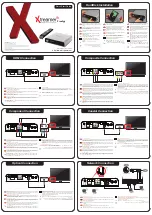
Page 66 MS-SOUND decoders MS440 to MS990
CV
Denomination
Range
Default Description
During this adjustment CV #277 is to be left at “0” (de-
fault), so that the setting for “no-load driving” is not influ-
enced by load factors.
5.5
#276
volume
at high speed
without load
0 - 255
220
Like CV #275 (see above) but for driving fast.
Set the speed regulator to maximum during this set-up.
5.5
#277
Dependency of
chuff volume
of current
load
0 - 255
10
When deviating from the basic load (as determined by
the “Automated recording of the motor’s “basic load” fac-
tor”, see above), the chuff beat volume should be in-
creasing (on inclines) or decreasing on declines (even
muted).
CV #277 defines the degree of dependency; the proper
value has to be set by trial.
5.5
#278
Load changing
threshold
0 - 255
10
With this CV, a change in volume in reaction to small
load changes can be suppressed (i.e. in curves) in order
to prevent chaotic sound impressions.
Suitable settings can only be determined by trial.
5.5
#279
Load changing
delay
0 - 255
1
This CV determines how quick the sound reacts to load
changes, whereas the factor is not just time but rather
“load-change dependent time” (= the bigger the change
the faster the effect). This CV is also used to suppress
chaotic sound changes.
Suitable settings can only be determined by trial.
5.6
#280
Diesel engine
-
Load dependency
0 - 255
10
With this setting, the diesel motor’s reaction to the load
(defined by PWM and speed step).
NOTE
: the sound of
the diesel motor practically always depends on accelera-
tion and speed.
Diesel-hydraulic loco - higher and
lower PWM and performance steps,
Diesel-electric loco - driving/idle
Loco with switchgear - steps.
= 0: no influence motor PWM according to speed
= 1 to 255: increasing to maximum influence
NOTE
: It is recommended, first to perform the
auto-
mated test run
with CV #302 = 75 first (see chapter 5.3).
5.5
#283
Driving noise-
(Steam chuffs)
Volume -
for full acceleration
sound
0 - 255
255
The volume of steam chuffs at maximum acceleration is
set with CV #283 (default: 255 = full volume).
If CV #281 = 1 (acceleration threshold set to 1 speed
step), the volume defined here is applied with each
speed increase, even if it’s just 1 step.
5.5
#284
Deceleration
threshold
for
reduced volume dur-
ing deceleration
0 -255
(Internal
Speed steps)
1
Steam chuffs should be played back at less volume (or
muted) signifying the reduced power requirement during
deceleration. The sound reduction logic is analog to a re-
versed acceleration (per CV #281 to #283).
= 1: Reduces sound to a minimum (as per CV #286)
when speed is reduced by just 1 step.
= 2, 3 ... sound reduced to minimum after
lowering speed by this number of steps.
5.5
#285
Time needed for the
volume reduction
at deceleration
0 - 255
=
30
After the speed has been reduced, the sound should re-
main quieter for a specific time (analog to the accelera-
tion case).
CV
Denomination
Range
Default Description
0 - 25 sec
Value in CV #285 = time in tenth of a second!
5.5
#286
Volume -
of reduced
driving noise-
at deceleration
0 - 255
20
CV #286 is used to define the chuff volume during decel-
eration (default: 20 = pretty quiet but not muted).
If CV #284 = 1 (deceleration threshold set to 1 speed
step), the volume defined here is applied with every re-
duction in speed (even if decreased by just 1 step).
5.3
#287
Threshold
for
brake squeal
0 - 255
50
The brake squeal should start when the speed drops be-
low a specific speed step. It will be automatically stopped
at speed 0 (based on back-EMF results).
5.3
#288
Brake squeal
minimum drive time
0 - 255
=
0 - 25 sec
50
The braking squeal is to be suppressed when an engine
is driven for a short time only, which is usually a shunting
run and often without any cars (in reality it is mostly the
cars that are squealing not the loco itself!).
NOTE
: Brake squeal sounds can also be assigned to a
function key (see allocation procedure CV #300 = …),
with which the brake squeal can be started or stopped
manually! (SW version 5.00 and higher)
5.6
#289
Thyristor
Step-effect
0 - 255
= 1 - 255: Effect of pitch
5.6
#290
Thyristor sound
pitch:
“slow” pitch increase
0 - 255
50
Sound pitch for speed defined in CV #292.
5.6
#291
Thyristor sound
pitch:
Maximum pitch
0 - 255
255
Sound pitch at top speed.
5.6
#292
Thyristor sound
pitch:
slow speed
0 - 255
128
Speed for sound pitch per CV #290.
5.6
#293
Thyristor sound
pitch:
Steady volume
0 - 255
100
Thyristor sound volume at steady speed (no acceleration
or deceleration in progress).
5.6
#294
Thyristor sound
pitch:
Vol. at acceleration
0 - 255
Volume during acceleration
5.6
#295
Thyristor sound
pitch:
Vol. at deceleration
0 - 255
Volume during heavier decelerations (braking)
5.6
#296
Electric motor
Volume -
0 - 255
0
Motor sound volume.
5.6
#297
Electric motor
Minimum load
0 - 255
0
Internal speed step at which the motor sound becomes
audible; at this speed step is starts at a low volume and
reaches maximum volume as per CV #296 at the speed
step define in CV #298.
5.6
#298
Electric motor
Volume -
Speed dependency
0 - 255
0
Internal speed step at which the motor sound reaches the
maximum volume defined in CV #296.
See ZSP manual!













































